When planning an outdoor activity such as trekking or hiking, it’s common to think about the route, equipment, food, weather, and safety. But for us women, there is one more factor to consider: what if our period starts? How can we stay comfortable and safe without harming the environment with waste?
Menstruation affects every woman differently. While some suffer from cramps, others go through their period naturally, only managing the flow, which can be light or heavy. “Some women may experience leg and lower back pain, feel weaker, or have mood swings, and all of this can happen during an expedition,” explains Fernanda May, a sports doctor and mountaineer.
This is the case for Bia Carvalho, who usually takes medication to manage the discomfort caused by her period. “I prefer to schedule activities for times when I’m not menstruating, but if I already have something planned, I take medication to relieve cramps.”
To Block or Not to Block Your Period?
Because of discomforts like the ones Bia experiences, many women choose to suppress their period. This was the case for Fernanda May, who did so for 20 years. “My menstrual flow was very heavy, and I had severe cramps and PMS. For me, menstruation was suffering. I took the pill continuously and only stopped when I wanted to get pregnant. Besides, I didn’t want to depend on dates to schedule my challenges.”
According to the doctor, this practice is adopted by many high-performance athletes since menstrual discomfort can compromise months of physical and financial preparation for competitions and expeditions.
Another common strategy is the temporary suppression of menstruation by taking back-to-back pill packs only for the expedition month. “A woman needs to know her cycle to decide whether to suppress her period. This choice should always be made under the guidance of a gynecologist,” explains Fernanda.
She also warns about the risks of trying a new hormonal method in the month of the expedition, especially in high-altitude environments. “Starting a new pill or any other contraceptive can increase the risk of thrombosis. The ideal is to stick with what you’re already used to. If you plan to take back-to-back pill packs, start 4 to 6 months in advance, at the beginning of the expedition preparation, and always follow your doctor’s guidance.”
Pads, Tampons, Menstrual Cups, or Absorbent Underwear?
The choice of menstrual product is highly personal, but two aspects should be considered when planning an expedition: the hygiene options available in the location and the environmental impact of waste generation.
Regardless of your choice, personal hygiene should be a top priority during menstruation in outdoor activities. Washing your hands thoroughly before and after handling any menstrual product helps prevent contamination.
“In high-altitude expeditions or long trails, women need to pay extra attention to hygiene, as we can go days without showering, with hands dirty from soil. Even if we try to clean them, we may not always achieve the ideal hygiene level when changing a pad or menstrual cup. This increases the risk of urinary tract infections and vaginitis,” explains Fernanda May.
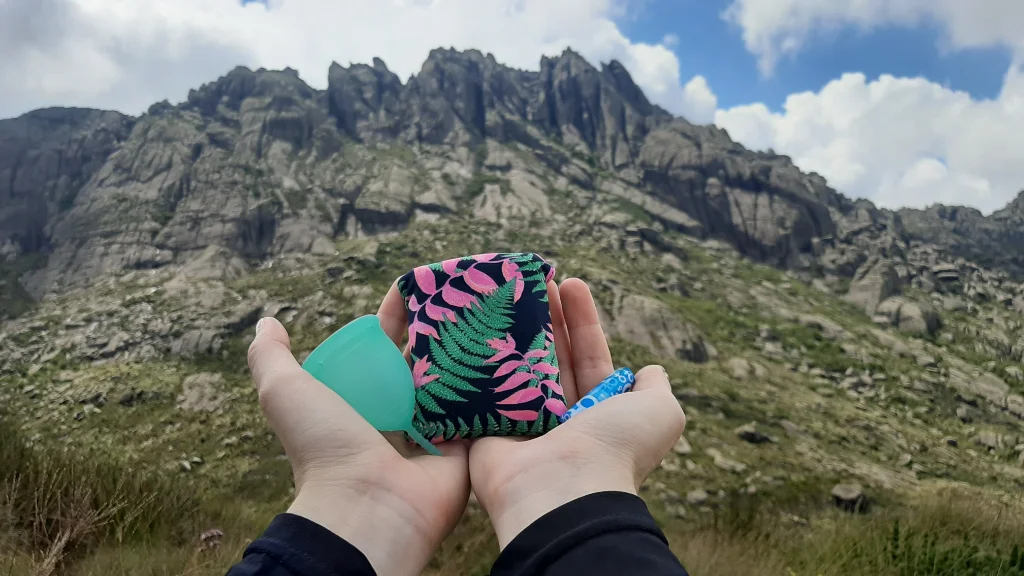
Photo: Danielle Hepner
In addition to personal health concerns, we must also protect ecosystems. Disposable products or those with packaging, such as tampons, applicators, pads, wet wipes, and toilet paper, should always be carried out. A sealed plastic bag designated specifically for waste is a good solution to store these items until they can be properly disposed of.
Below, we present different menstrual product options, highlighting their convenience for outdoor use and recommendations to minimize environmental impact:
External Pads
Although external pads are easier to use, it’s crucial to be aware that they generate waste that must be carried out to avoid impacting the environment—the same applies to tampon applicators.
“Depending on a woman’s flow, she may need to change her pad five to six times a day, which generates more waste. This can be an issue since she will have to carry them in her backpack until proper disposal, which adds weight and odor,” explains Fernanda.
Danielle Hepner has been practicing outdoor activities since 2015 and has tested various types of menstrual products. Due to the severe pain caused by endometriosis and her heavy flow, she opts for disposable external pads, which offer her more comfort during expeditions.
“I tried to adapt to the menstrual cup since it’s more sustainable, but I felt a lot of pain when inserting and removing it, as well as discomfort while walking. Menstrual underwear also didn’t work for me because my flow is heavy, which made me anxious.”
Concerned about sustainability, the mountaineer uses organic and compostable pads from brands like amai and Libresse, which cause less environmental impact compared to traditional ones.
“This was the best way I found to feel safer and more comfortable during expeditions, despite the bulk. Another point is that when we spend a lot of time in nature, it’s difficult to maintain ideal hygiene, which makes us more prone to infections.”
Between pad changes, Danielle uses hand sanitizer and wet wipes, which she only adopts during menstruation for a more effective hygiene routine. To transport used pads, she uses the Trash dry sack Sea to Summit, which helps contain odors and is reusable.
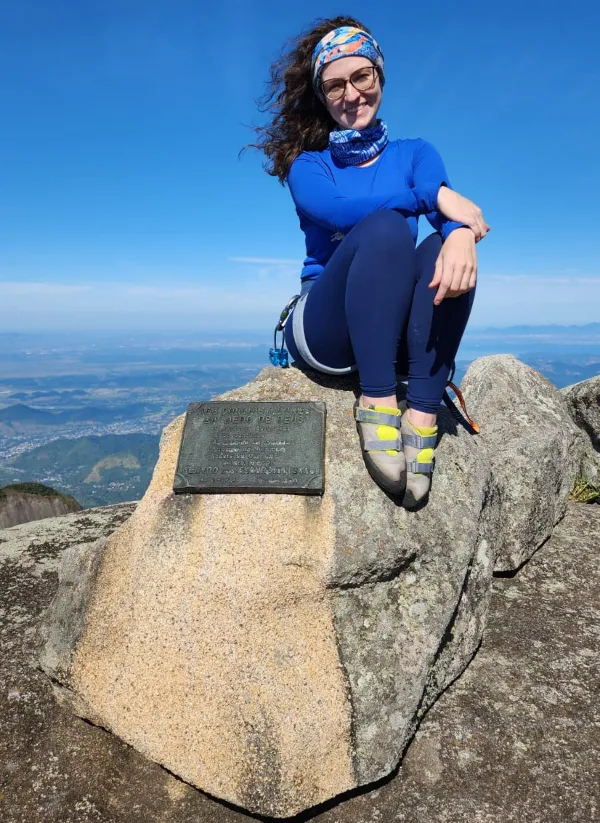
Danielle Hepner
Internal Tampons
Dr. Fernanda May advises caution when using tampons due to hygiene concerns. “When I prepare my patients or go on an expedition with women, I advise them to avoid tampons if possible, as they require inserting fingers into the vagina. Since hands are usually dirty during outdoor activities, this increases the risk of infections.”
Bia Carvalho usually uses a menstrual cup for short, one-day activities, but for longer expeditions, she prefers biodegradable applicator tampons, which prevent direct hand contact. “If I’m going to spend multiple days in the mountains, in remote environments with limited water to clean the menstrual cup, I prefer tampons with cardboard or similar applicators. During the Pacific Crest Trail (PCT), I spent many days in the wilderness, and tampons were my go-to choice.”
When necessary, Bia used the most naturally made wet wipes possible for intimate hygiene inside her tent. “At that moment, the tent was just mine, and I took care of my hygiene. I also used a PET bottle filled with water to rinse myself after going to the bathroom and to do a general wash at the end of the day. I stored the used wipes to take them back home.” Her solution for carrying used tampons was a Ziploc bag.
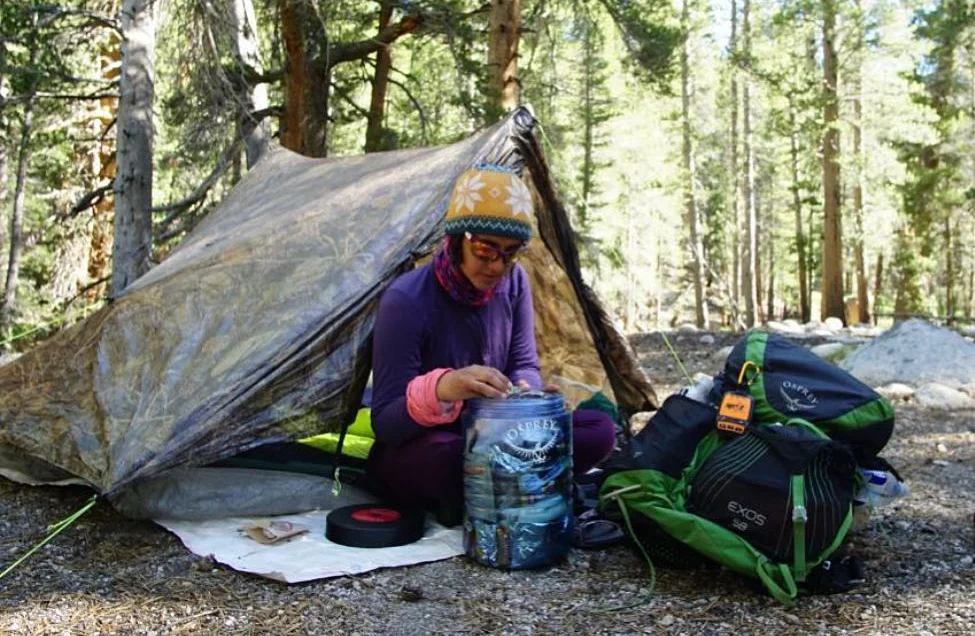
Bia Carvalho on the Pacific Crest Trail
Remember that all disposable products must be packed out. Burying tampons or discarding them in latrines is not a sustainable option, as they do not decompose and can pollute the environment.
Menstrual Cup or Disc
Menstrual cups and discs are reusable and produce less waste, making them an eco-friendly alternative. According to Fernanda, this option also provides greater hygiene security, as long as women are careful to handle them with clean hands to minimize exposure to bacteria.
“If a woman doesn’t have a very heavy flow and is already accustomed to using one, a menstrual cup is a great option. She can insert it in the morning at camp with clean hands and only remove it at the end of the day when reaching the next camp. If resources allow, she can sterilize it with boiled water. In terms of waste reduction and ease of use, a cup is the best choice, provided she can go the whole day without leaks.”
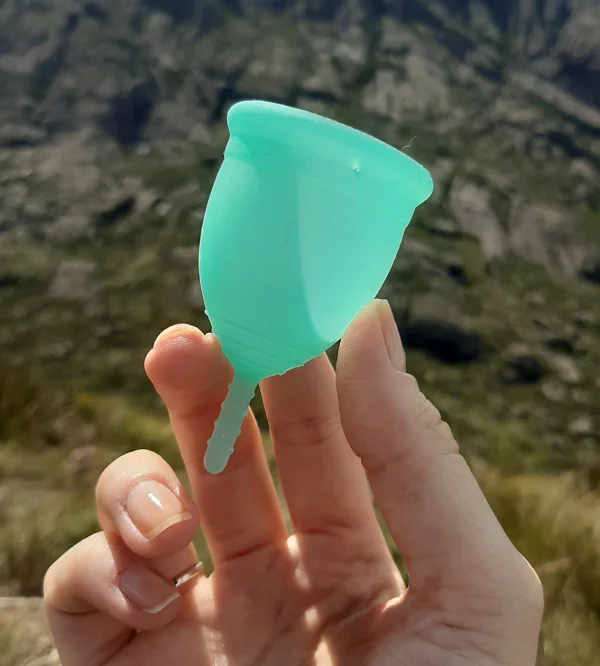
Menstrual cup. Photo: Danielle Hepner
To minimize environmental impact, menstrual cups should be cleaned with potable water and biodegradable soap at least 60 meters (about 70 large steps) away from trails, campsites, or water sources. Additionally, you should dig a hole 15 to 20 cm deep, as recommended by Leave No Trace, a leading organization in minimum-impact outdoor practices. “The best way to empty a menstrual cup is to dig a hole, pour the blood into it, and bury it to avoid odors that might attract animals,” Fernanda explains.
If you are using a menstrual cup and feel comfortable, or if local regulations require it, you can carry the menstrual fluid with you in a sealed container or in a designated waste disposal bag (WAG bag).
Reusable Cloth Pads and Menstrual Underwear
Maria Clara Borsoi de Moraes, an instructor for the Leave No Trace course—who has led a women-only group—mountain guide, and environmental educator, didn’t adapt to using a menstrual cup due to cramps. Instead, she uses reusable cloth pads and is considering switching to menstrual underwear.
“My flow isn’t too heavy, so this solution is perfect. It doesn’t cause allergies or irritation. But if I could use a cup, I definitely would because of waste management. You have to find solutions that make you as comfortable as possible while ensuring that waste is disposed of properly to minimize environmental impact.”
Maria Clara does not usually wash cloth pads in areas with scarce water, such as the Marins x Itaguaré and Serra Fina crossings. “In some places, you can’t even dig a cathole to dispose of blood. So, I prefer to store and clean them at home,” says the guide, who carries used cloth pads in a small, waterproof bag designated solely for that purpose.
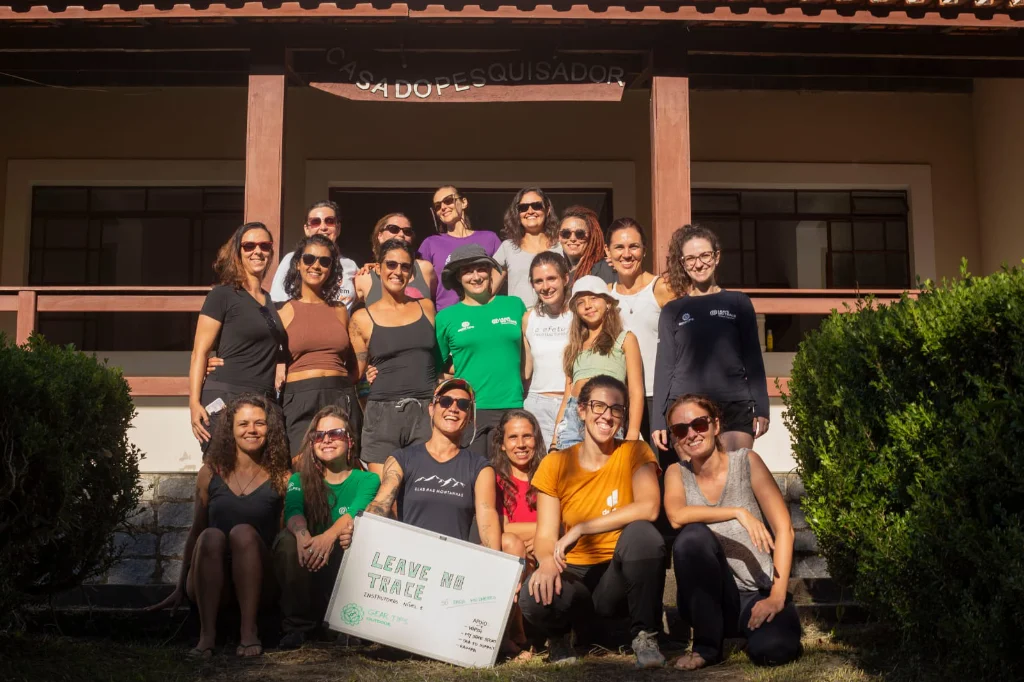
Maria Clara with a group of women who participated in the “Leave No Trace Level 1” course exclusively for women
According to Fernanda, menstrual underwear can also be a zero-waste option, but they need to be washed between uses.
“If you have access to a refuge where you can wash menstrual underwear overnight, they are a great option since you can wear them all day. There are models for both light and heavy flows. In terms of environmental impact, they are a good alternative because they don’t generate waste. Women just need to be mindful of where they wash them, as wilderness and high-altitude environments don’t have proper facilities. It’s important not to wash them in rivers or waterfalls,” explains the doctor and mountaineer.
Just like menstrual cups, underwear should be washed at least 70 large steps (about 60 meters) away from trails, campsites, or water sources, using biodegradable soap. After washing, disperse the used water on the ground. Always bring extra pairs to wear while your menstrual underwear dries.
IMPORTANT: To wash any product that comes into direct contact with the body, always use clean and disinfected water. Do not use water from natural sources without filtering or boiling it first, as pathogens in the water can cause infections.
What If Your Period Starts Unexpectedly?
Even if your cycle is regular, and you plan your trip outside of your period, it’s always a good idea to bring supplies such as tampons, pads, a menstrual cup, or menstrual discs. The stress of being on a new adventure, in a different environment, as well as intense physical activity, can alter your cycle, so it’s always best to be prepared.
Maria Clara experienced this firsthand: “I was on an expedition to Cerro Plata in Argentina with a friend, carrying all our gear independently, with a lot of weight. My cycle is regular, but this was my first experience in high-altitude mountaineering. We went through the acclimatization process, rested, but on summit day, my period arrived unexpectedly. I wasn’t feeling well and wasn’t prepared for it in a new environment, in the cold, and at high altitude. I decided to descend. We have to understand that our bodies will feel different during this phase. Respecting that moment is important.”
If you are leading or guiding a group, carry menstrual products and pain relief medication for everyone, regardless of whether they menstruate or not. Be informed so you can offer support if someone is unsure how to manage their period in outdoor environments or experiences their first period during the trip.
In her work as a mountain guide, Maria Clara brings pads for the women in her groups and also provides guidance so they feel safer and more comfortable. She even encouraged the men in her agency to do the same. “Everyone should have a pack of pads available for the women they guide. I started raising awareness about this so they can be prepared to support female clients.”
What to Include in Your Menstrual Management Kit:
- Sealed, waterproof, or Ziploc bags to store used items;
- Fragrance-free wet wipes or toilet paper. If possible, replace them with a squeeze bottle for rinsing;
- Hand sanitizer;
- Pain relief medication that you are accustomed to using.
In addition to these items, Danielle Hepner uses a pain relief patch for cramps and discomfort.
Other Hygiene Tips for Women
Participants in the Leave No Trace course, part of the Gear Tips Empowerment Program, learned a hygiene technique using a squeeze bottle to clean themselves without generating waste like toilet paper or wet wipes. The water bottle should be used for a thorough wash of intimate areas.
Fernanda May points out that this technique is effective but highlights an important detail for women: “The water stream should be directed from front to back, preventing fecal residue from entering the vagina, which could lead to infections.”
Another valuable tip from the doctor, which she applies in her own expeditions, is using a small cloth known as a *pee cloth* for drying. “It contains silver fibers, dries very quickly, doesn’t retain odors, and doesn’t generate waste. You can hang it on your backpack or store it in a pouch. You can use it all day.”
Finally, the key is to plan ahead and not let menstruation stop you from enjoying outdoor activities, as our expert partner Laila Blanch explains in the video “Menstruation in the Mountains: Should You Go Trekking During This Time?”:
We also recommend reading the publication A Period Guide for the Outdoors from Leave No Trace.
This post is also available in: Português (Portuguese (Brazil)) Español (Spanish)
